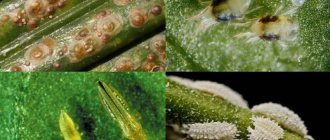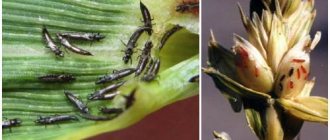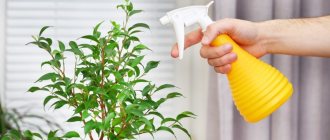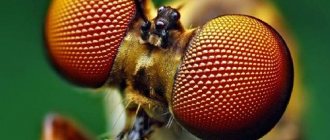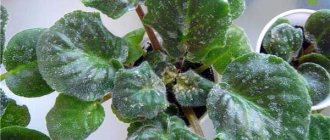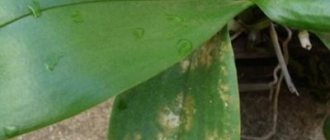Houseplants are often exposed to a variety of diseases and pests. One of these is the whitefly. This small, inconspicuous insect can cause enormous harm to the plant and even lead to its death. To avoid such sad consequences, you need to detect the pest in time and get rid of it. Fortunately, there are many ways to combat it. You can use both chemicals and folk remedies, which are no less effective.
Description and types of whitefly
It is not so easy to see whiteflies - they have tiny sizes, from 1.3. mm. up to 2.5. mm. depending on gender. They are necessarily white or predominantly white in color - only this feature makes them noticeable on the soil of the pot and the flower itself; they resemble moths in appearance.
REFERENCE! Adult whiteflies cause a lot of harm - for example, they spread phytoviruses. But the larvae of these insects are much more dangerous for plants - they eat a lot and quickly, and also securely attach themselves throughout the plant, destroying it.
It is easier to detect whiteflies in motion - having settled on a flower, they actively move around it and hide when a threat appears. If you see an insect but are not sure, look at photos of whiteflies on houseplants from other gardeners.
Tobacco or cotton
The main danger of these insects is the transfer of viruses to a variety of plants - not a single flower can be insured against this. The most common type.
Greenhouse or greenhouse
It is possible that your pests are of this particular species - it is the second most common. These insects breed all year round and can easily be carried into your apartment by the wind.
Asian or citrus
Not very common, it can mainly be found in the Caucasus or the Black Sea coast.
Most likely you will find representatives of the first two species on your plants. They reproduce quickly, and adults run away from danger - which is why it is necessary to destroy them as quickly as possible from the moment of discovery.
Description of the flying pest
The whitefly on flowers looks harmless, but causes great harm to plants. Outwardly, it looks like a small moth. You can recognize a whitefly by its white wings covered with a waxy powdery coating. The insect's body length is no more than 2-3 mm.
Whiteflies hide on the undersides of leaves and leave their eggs there. The danger comes mainly from the larvae - they feed on the juices of the plant, leading to its death. One female lays about 300 eggs per month. The lifespan of an insect is about a month.
Whiteflies are carriers of dangerous viral and infectious diseases. Due to its rapid reproduction and ability to fly, whiteflies are difficult to breed. If at least one insect is noticed on the plant, you need to carry out treatment as soon as possible and carefully inspect all the flowers in the house.
There are different types of whiteflies - greenhouse, citrus, strawberry. In apartments, greenhouses are most often installed. They do not disdain any plants; most often they attack pelargonium, balsam, fuchsia, gloxinia, and calla lilies.
Causes of pests
You don’t need to do anything specific for whiteflies to appear - these insects move with the wind, so they can settle completely by accident. Most often this happens in spring and summer, when the air is warm and the windows are open.
These parasites also infect the soil with their larvae - the eggs easily tolerate cold and begin to actively develop only in suitable conditions. To avoid this option, buy flower soil in a safe, sealed package, or take any soil, but process it at high temperatures.
Why does whitefly appear?
This pest can live anywhere - in greenhouse conditions, gardens, orchards, therefore:
- whiteflies can fly into an open window in spring or summer and will live on house flowers;
- the pest can be brought into the apartment with a new plant purchased in a specialized store or greenhouse, it is there that these “harmful” bugs can be found in large numbers;
- These insects can also enter the apartment along with soil components or when transplanting adult flowers.
Whitefly - method of fighting it with water - video
Important!
The eggs of this pest are not afraid of frost and quietly overwinter in the ground. Whitefly larvae begin to hatch from their eggs if they are placed in a warm, dry room. Therefore, after preparing a nutrient substrate from components that are stored from the garden, it should be disinfected - calcined in the oven, heated in a water bath or spilled with a weak solution of potassium permanganate.
In comfortable home conditions, a whitefly can live in an apartment for years.
How to detect
Whiteflies on indoor plants are noticeable due to their white color and chaotic movement. There can be a large number of adult insects on one flower at the same time, so you will most likely notice them quickly.
Most often, the pest hides under the leaves of the plant (if there are any - and the whitefly prefers deciduous species). Lift one leaf and shake it a little - the adults will scatter and you can see the small spherical capsules of the larvae. They are covered with a dense layer of waxy substance that protects them from almost any external influence.
Peculiarities of the pest's life
Whitefly is an extremely difficult pest to remove, very often appearing on indoor plants. Moreover, this parasite is also difficult to notice. The fact is that this parasite looks extremely inconspicuous. Externally, the whitefly is somewhat reminiscent of a moth, only in a special shade. This pest has a flat, flattened body. As for its color, much depends on the type of whitefly. But most often the pest’s body is pale, yellow-red, white or greenish.
Interestingly, the pest got its name thanks to its wings, the color of which is snow-white or cream. It is by these wings that you can identify the pest that has “visited” your plant.
Another peculiarity of the pest is that it is one of the few insects that react almost instantly to danger. As soon as you even slightly touch the bush on which these pests are located, they instantly take off and land back on the bush only if it is in a complete state of rest.
The danger of this pest lies in the fact that this pest is very voracious. No wonder they compare him to locusts. So if even one of your plants has been attacked by it, then immediately take control measures, and also carry out preventive measures for other plants in the house, greenhouse or garden.
Initially, this pest operated in the warm and humid climate of South America, but gradually, together with exotic plants, it moved to other countries of our planet. Today, the whitefly family includes more than 1,500 different species. Most of them prefer a warm and humid climate, the same as in their “homeland,” but if you live in a temperate or even cool climate, then you should not relax, because some types of whiteflies have become accustomed to surviving in difficult conditions.
However, most whitefly species are active exclusively in the summer, especially on plants located outside. As for the cold seasons, the pest prefers to survive them in the form of larvae and eggs, which the whitefly lays in secluded places.
It is almost impossible to find such places on purpose, so the best means of combating whiteflies is preventive measures. But do not forget that the pest is capable of operating in houses and greenhouses, and in such conditions it is capable of causing harm and multiplying all year round.
However, the main danger from the pest comes in the summer. It is during this period that the peak of reproductive activity occurs. For example, individual females are capable of laying almost 300 eggs at a time. Individuals are formed quite quickly. The first larvae will appear on your plant in just 10 days. And they do even more harm than adult larvae. They become adults in a month, sometimes in 20 days. And most importantly, as statistics show, almost all individuals survive until this period.
Thus, the pest can multiply to incredible numbers. Sometimes only one generation is capable of producing 2-3 cycles of offspring. This means that on just one plant the whitefly can be present in all its forms. The individual does not live long, about 3 weeks. But during this time she manages to do a lot of nasty things.
An interesting fact: despite the fact that the insect loves warm regions and warm seasons, intense heat simply kills the pest. For example, at air temperatures above 30°C, the lifespan of an insect is reduced to several days. A similar situation occurs at temperatures below +18°C.
Signs of plant infection
You don't have to look out for insects to understand that something is wrong with the plant. There are several signs of infection, having noticed which you can definitely start thinking about how to treat your plants against whiteflies.
The main signs of the appearance of parasites:
- The plant itself fades - it begins to wither and turn yellow for no objective reason. This happens because adult insects introduce viruses and leave honeydew (more on that below), and the larvae feed abundantly on the juices of the flower.
- Honeydew or honeydew appears on the leaves and stem - a sticky silvery-white coating secreted by adult insects. If there are such traces, then the pests have already firmly established themselves on the plant.
- White, and then black, spots on the leaves and stems from sooty fungus. This sign suggests that saving the plant will no longer be easy. Sooty fungus appears shortly after honeydew - their development is interconnected.
If you notice any of these signs, look for insects or larvae. As soon as your fears are confirmed, try to figure out what phase of reproduction the pests are in - this is critically important for controlling whiteflies on plants.
IMPORTANT! Be sure to isolate the plant as soon as you notice signs of infection - this is a necessary measure so that other flowers are not harmed. Whiteflies quickly invade neighboring pots as soon as the population becomes too large.
Larvae and adults require different measures for eradication - keep this in mind. First of all, try to destroy all adult insects - they multiply very quickly, and then tackle the larvae.
Other folk tricks
Glue traps
To make it easier to combat pests on plants, in addition to folk remedies or chemicals, glue traps can be used. They are excellent at catching adult insects.
To kill whiteflies, you can buy a glue fly trap or make one yourself.
.
Fungus gnats are trapped
.
How to make a glue trap for whiteflies with your own hands?
Paint a piece of plywood, cardboard or thick paper yellow. You can use white traps, but the yellow color attracts the attention of the pest more strongly.
Lubricate the trap with a sticky substance - castor or machine oil, Vaseline, rosin with honey.
Dichlorvos
You can fight the pest with dichlorvos, but only if there is no aquarium, children or animals in the house. To do this, spray dichlorvos in the morning and evening around the house plant.
Fumigator
If there is a separate sealed room (balcony, loggia) that no one will enter, then you can move your home flower into it for 2 days and turn on the fumigator with insect repellent plates.
You can also turn on the fumigator when you leave for work or at night and place the plant in the bathroom.
Benzyl benzoate for whitefly
Many gardeners advise using a treatment for scabies in the form of a benzyl benzoate emulsion rather than an ointment.
Dissolve a teaspoon of benzyl benzoate in 200 ml of water and spray the flower.
According to reviews, this is a very effective remedy that can remove whiteflies in one procedure. On average, the plant is sprayed 2-3 times every 5-7 days.
Fighting whiteflies using temperature (thermal method)
Insects do not tolerate low temperatures - less than 10 degrees Celsius. To do this, place the affected houseplant in a cool place. This method is an addition to flower treatments with drugs or folk remedies and is suitable for species that can withstand cold.
2ND OPTION . Heat the plant in a confined space (glazed balcony/loggia on a hot day or greenhouse) to 40-45 degrees Celsius. At this temperature the whitefly will go into thermal shock.
Biological control methods
These control methods are ideal for greenhouses and conservatories. Therefore, to remove the whitefly, it is recommended to use its natural enemies (lacewing, ladybug, macrolophus, encarsia and others).
Biological agents effectively destroy the pest without causing harm to humans and animals.
Chemical treatment
To successfully combat whiteflies on indoor plants, reliable chemicals have long been invented - all you have to do is select and apply them correctly. Many gardeners are afraid that the chemicals will damage the plant, but all insecticides that are used to kill whiteflies are designed to have minimal impact on house flowers and other cultivated plants.
Most of the products that will help you kill these parasites are long-acting - this is necessary, since some whiteflies can survive after treatment, and this is enough to restore the colony. Having chosen a drug, use it exactly according to the instructions, observing the dosage - you need to destroy the entire population at one time.
Aktara is considered the best insecticide against whitefly.
This drug is used most often - flower growers choose it due to its long-lasting action and prevention of re-infection for almost a month. It has a complex effect - after watering, it impregnates the plant and its juices, which the parasites feed on, with a deadly poison for them. The entire colony dies within a week or 10 days - you don't need to do anything for this.
Other effective drugs
Spark
An insecticide identical in action to Aktara. Valid for 25 days.
Confidor and its analogues
Not only kills the main colony after watering, but also has a contact effect (only against adult insects).
Akarin
Contact and food poison for whiteflies. You should not relax immediately after treatment - you need to monitor the plant for some more time to make sure that the whitefly has died as a whole in the colony. Relapses often occur, to which it is worth responding just as quickly.
How to recognize the presence of a pest
The structure of the oral apparatus of this insect is a thin chitinous proboscis , with which it pierces the leaf blades and sucks the juice from them. It is in the wake of this vigorous activity that it becomes noticeable that vegetable plants are being precipitated by whiteflies.
Externally, signs of damage look like this:
- the leaf plate of greenhouse crops is covered with yellowish dots less than a millimeter in diameter;
- gradually there are more dots, the leaf begins to fade;
- on the reverse side of the leaf blades you can see a sooty coating;
- On healthy leaves, clutches of yellowish small (up to 0.25 mm in length) eggs laid out in circles are found.
If there are a lot of insects, the surface of the leaves is literally covered with the products of their vital activity - honeydew, which is the excrement of whitefly aphids. It becomes a kind of soil for fungi.
That is why the lack of insect control can lead not only to weakening of crops, but also to massive damage to vegetable plants by fungal infections.
Non-chemical plant treatment
If you don’t have a chemical on hand, and you need to start understanding how to deal with whiteflies on indoor plants now, you can try methods that do not involve insecticides.
First, try to clean the plant mechanically - take it out into the open air and carefully shake off the adult insects, then take the pot away. Of course, you won’t be able to kill the entire colony this way, but you will improve the situation. Do not try to remove the larval cocoons - they are securely attached to the leaf, so you will only scratch the plant.
Another option is glue traps. Whiteflies are very light insects, so even a small layer of glue will be fatal to them. Traps can be purchased or made; bright yellow is recommended. You don't need to do anything - just place a few in and around the pot, the pests will stick to it on their own.
Our experience in fighting whitefly
We tried spraying with Aktara (1g per 1l of water) 3 times every 4-5 days. There was an effect, but few whiteflies appeared again.
Then they started adding the drug Mospilan to Aktara. It helped, but we didn’t completely get rid of the whitefly.
Then we decided to try the new drug Admiral (1 ml per 5 liters of water).
The effect was very good : the whitefly practically disappeared.
And when we added Mospilan to the drug Admiral, we were able to defeat the whitefly! Now, even when we keep our plants in the garden during the warm season, the whitefly does not annoy us. Two or three preventive treatments at the end of summer and beginning of autumn are enough and our plants feel very well without pests.
The best folk remedies for whiteflies
There are also effective folk remedies - with them, the fight against whiteflies is possible even on indoor plants with increased sensitivity to treatment. The first place to start is with processing and cleaning. Drive away as many insects as you can and start removing all the affected parts of the plant - leaves and shoots in the fungus. Remove honeydew too.
The most popular folk methods.
Garlic infusion
You need three cloves of garlic and a liter of boiling water - mix it and leave it in a dark place for a day. Spray the plant well with this liquid from a spray bottle, without watering it under any circumstances.
Soap solution
Prepare it carefully - you only need one tablespoon of grated soap and 6 liters of water. Reduce the proportions to the required level and spray; watering is also strictly forbidden.
Dichlorvos
Do not spray the plant directly, it is very harmful. Soak a piece of cotton wool in the chemical, place it in the pot and place the flower in a bag or bag that can be tied. After tying it, leave it for five hours.
If this does not help, it is recommended to return to insecticides - it is better to risk the health of the plant a little (although the likelihood of this is exaggerated) than to risk losing it completely.
Getting rid of butterflies using “chemistry”
If plants are infected by whiteflies, controlling them with chemicals will be most effective. The soil in the pot or the plant itself is sprayed with the purchased preparation, which is absorbed into the leaves, stems, roots and gets into the juice. And as you know, the pest and its larvae feed on this very juice.
To quickly destroy whiteflies, you should pay attention to the most effective means, among which we can recommend:
- Aktara . This drug is wonderful because it has a long period of action, protecting the plant from 3 to 5 weeks. It is quite simple to use; you just need to pour the diluted solution onto the affected flowerpot at the root. If the case is very advanced, you can sprinkle the leaves and stems with the product. Also, to ensure quick results, it is recommended to make the solution 2-3 times stronger than what is written in the instructions. This will not harm the plant, but the pest will disappear 100%.
- Confidor . A fast-acting insecticide, after spraying and watering with which insects begin to die within 1.5 hours. Most often, just one treatment is enough.
- Spark . A very effective product that destroys whiteflies after one watering.
- Akarin (Agravertin) . Using this product you can get rid of almost any pest. In order for the result to be as effective as possible, you need to spray the plant thoroughly, trying to get it directly on the insects themselves, especially in places where they accumulate.
- Aktellik . The drug is also fast-acting and does not require secondary processing. But it is worth remembering that it is very toxic and has an unpleasant odor.
Processing rules
Depending on the substance, one of the treatment methods is selected - watering or spraying. Most insecticides work in the first way - in order to saturate the plant and kill numerous larvae, folk remedies, on the contrary, usually require spraying.
Often these measures intersect with each other in a variety of processing methods. Experienced gardeners advise not to neglect spraying in any case.
Preparations to combat whitefly
Effective formulations of different combinations of drugs and proportions of solutions for treating plants against whiteflies.
| Admiral 0.05% + Match 0.15% |
| Aktara 0.05-0.08% + Fitoverm 0.5-0.8% (5-8 g/10 l of water) |
| Aktellik 0.15% + Talstar 0.05% + Admiral 0.05% |
| Actellik 0.15-0.2% (15-20 g/10 l of water) + Aktara 0.05% (5 g/10 l of water) + Aplaud 0.1% (10 g/10 l of water) |
| Apache - 0.04% |
| Calypso 0.04-0.05% (4-5 g/10 l water) |
| Lannat - 0.2-0.25 + Admiral 0.05% |
| Lannat - 0.2-0.25 + Match 0.1-0.15% |
| Lannat (Methomil) - 0.2-0.25% |
| Match 0.15% + Admiral 0.05% |
| Movento 0.1% |
| Movento-Energy 0.05-0 |
| Mospilan 0.04-0.05% (4-5 g/10 l of water) + Admiral 0.05% (5 g/10 l of water) |
| Mospilan or Aktara 0.05% (5 g/10 l of water)+Talstar 0.05%+Admiral 0.05% |
| Mospilan or Aktara 0.05% + Admiral 0.05% + Aploud 0.08-0.1% |
| Mospilan or Aktara 0.05% + Aplaud 0.05-0.1% (5-10 g/10 l of water) |
| Oberon-Rapid 0.05-0.1% |
| Plenum - 0.06-0.08% |
| Sunmite 0.1% (10 g/10 l of water) + Admiral 0.05% (5 g/10 l of water) |
| Talstar 0.05% (5 g/10 l of water) + Aktara 0.05% (5 g/10 l of water) |
| Tepeki - 0.03-0.04% (3-4 g/10 l of water) |
| Tepeki - 0.03-0.04% + Admiral 0.05% |
| Fitoverm M 0.2 against whitefly 0.5-1% |
| Exirel 0.1% + Admiral 0.05% |
| Exirel 0.1% + Match 0.1% |
| Exirel 0.1% + Tepequi 0.05% |
| Exirel 0.1-0.15% |
Online store Fazenda plus
Prevention measures
You won’t be able to completely protect your flowers from the possible appearance of whiteflies - but you can do everything possible. The best thing you can do to keep your houseplants safe is to install mosquito nets.
IMPORTANT! It is highly likely that you will get whiteflies if you grow tomatoes at home - these pests love them very much. Try to keep such seedlings away from flowers.
It is not worth treating plants with chemicals prophylactically - this can be harmful. Try to inspect the flowers more often. As soon as you notice several individuals, be sure to kill them - this way you can prevent the emergence of a colony.
Conditions for the appearance of whiteflies
The appearance of any pests or diseases is accompanied by improper and disturbed care, creating favorable conditions for their appearance and further reproduction. Let's consider under what conditions the probability of whitefly damage to a flower increases.
Pests usually appear during the hot summer period. Favorable conditions for whiteflies are a warm and constantly humid climate. At temperatures below 10 degrees, they cease to exist, but the eggs are able to withstand even minor frosts and wait for warmth to continue their vital functions. In winter, choose warm rooms, greenhouses, greenhouses. They are able to move from one plant to another, infecting the entire garden.
To prevent the appearance of whiteflies, you must follow several rules:
- The room should be regularly and well ventilated
- Flowers are planted at a certain distance from each other
- Maintain moderate humidity
- Do not spray at low temperatures with high humidity
- Regularly treat the plant with growth stimulants (epin, houseflower, etc.) and apply fertilizers.
